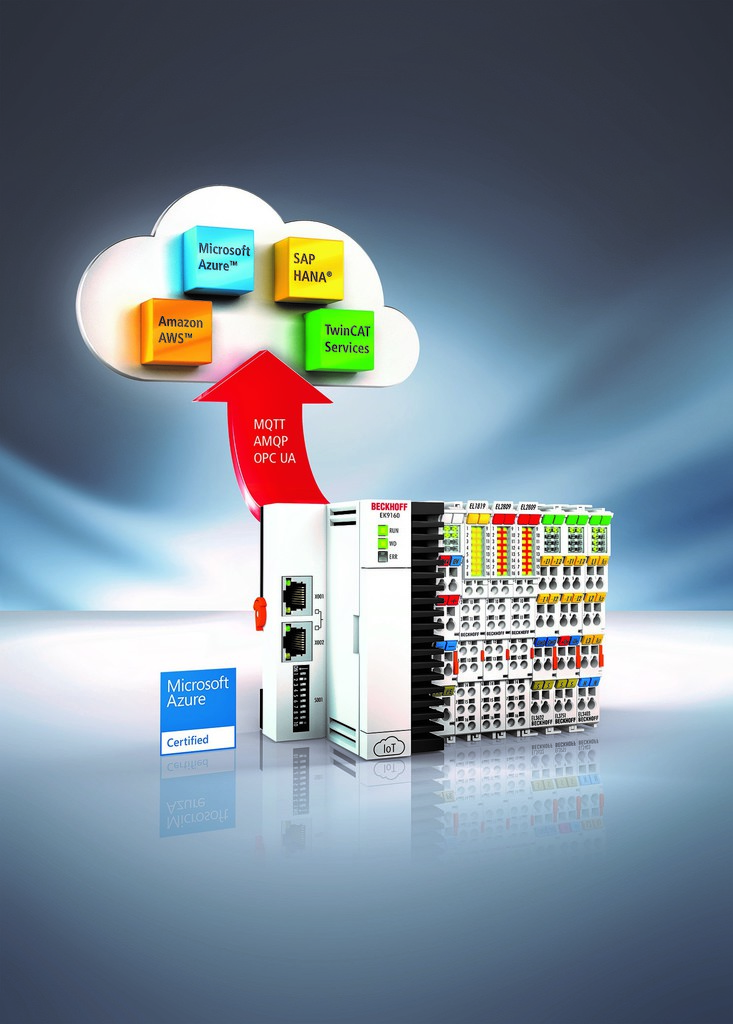
 |
Charlotte Stonestreet
Managing Editor |
Coupler for cloud-based control
16 June 2016
Beckhoff’s EK9160 IoT Bus Coupler transmits all control data simply, safely and cost-effectively to all common cloud systems in plug-and-play mode. Neither a controller nor programming is required through the implementation as a Bus Coupler-based solution.

The EK9160 establishes a direct connection without any special control program between Beckhoff EtherCAT I/O and the Internet of Things (IoT). As a result, the coupler enables simple and standardised integration of I/O data with cloud-based communication and data services.
Via an integrated web server, the I/O data can be parameterised, such as in data processing and timing, through a simple configuration dialog. No special engineering tools are needed. The EK9160 IoT Bus Coupler then autonomously transmits the data, including time stamp, to the cloud service.
Apart from that, extended mechanisms are available, including local buffering of I/O data on a microSD card (2 GB) to protect against data loss when the Internet connection is interrupted. The cloud services and security functions (encryption, firewall) can be configured via the web server in the same convenient way.
All major cloud systems are supported via the IoT protocols AMQP, MQTT and OPC UA (over AMQP): Microsoft Azure, Amazon Web Services (AWS), SAP HANA, as well as and private cloud systems in company networks. The EK9160 is "Microsoft Azure Certified" and enables communication with clouds based on advanced multi-cloud capabilities.
Publisher/subscriber communication
For data communication, the IoT Bus Coupler uses the publisher/subscriber communication principle. As a publisher, the EK9160 sends data to the cloud, enabling other applications to access the information as a subscriber. This application can then publish data itself if required, which in turn can be accessed by the IoT Bus Coupler. The devices do not need to “know” each other or individual IP addresses, rather only the central message broker, so the individual applications operate in “decoupled” mode. Moreover, communication for both the publisher and subscriber is always active and directed externally. Both of these factors mean that the firewall configuration and setup in the IT infrastructure of a company are simplified considerably.
These advantages can be utilised in all areas of industrial engineering and building technology. Standalone solutions, for example for small manufacturing systems, as well as complex machines and building services systems, for example, are possible. The selected cloud system is not a critical factor here, given the option to choose a public cloud or a local solution in a company network. Depending on requirements, services offered by the cloud provider and individual tools or services from third-party providers can be used as needed.
In conjunction with the industry-leading portfolio of EtherCAT I/O Terminals offered by Beckhoff, the EK9160 can be used to transmit the widest range of machine and building data types to the cloud, such as temperature, pressure, vibration or energy consumption. Added to this is the possibility to monitor connected fieldbuses. The I/O signals can not only be collected via EtherCAT, but also via the monitor operating mode of CANopen or PROFIBUS Terminals, for analysis by external specialists, for example.
Cloud-based control via the IoT fieldbus
In addition, the concept of cloud-based control can be implemented using the IoT fieldbus. In this context, TwinCAT software resides as an IoT controller in the cloud and acts as an MQTT message broker. The required data is supplied by IoT devices such as the EK9160 that can be installed in globally distributed locations, if required. In this application scenario, the IoT fieldbus, which has been implemented by Beckhoff based on the MQTT protocol, supports the necessary publisher/subscriber communication. As a result, all requirements can be fulfilled to simply and reliably relocate the control and data analysis processes to TwinCAT in the cloud.
- Packaging with planetary precision
- FANLESS COMPACT PC CONTROL
- New multi-axis robot system
- Beckhoff introduces new Solution Provider programme
- Virtual visits keep industry connected
- Battery production crucial for EV accleration
- Ultra compact IPC
- Small batch, big impact
- Entry-level industrial PCs
- Many-core machine control


















